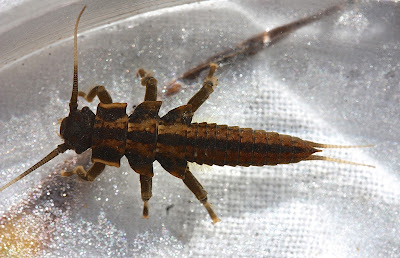I went to the North Fork of the Rivanna this morning, and if you've read blog entries from previous summers you know that I go there for only one reason: to photograph the common netspinner Macrostemum. I had no trouble finding Macrostemum larvae -- but this was the catch of the day. Giant stonefly, Pteronarcys dorsata. I found one last week in the Rivanna at Crofton, but the colors on that one weren't very pronounced. This was a beauty.
While we associate Giant stoneflies with clean, cold, mountain streams and expect to see them -- mature nymphs at least -- in the winter, this is a species that we find in the summer and fall in warm water rivers and streams, rivers like the Rivanna. Let's look at Beaty's ID:
P. dorsata -- frontoclypeus with lateral and somewhat truncate lobes adjacent to antennal pedicels; lateral angles of pronotum produced, anterolateral ones almost hook-like; no lateral projections on abdominal segments; each tergite with anterior and posterior abdominal spots sometimes confluent to give the abdomen a longitudinally striped appearance (3-5 stripes possible). Common and widespread (excluding Slate Belt). Univoltine although BAU data suggests a semivoltine life history with nymphs most abundant from June to October. Associated with Podostemum ceratophyllum (riverweed). ("The Plecoptera of North Carolina," p. 28)
1) From conversations with Steven Beaty, I've concluded that the shape of the frontoclypeal "lobes" is not that important for identification. But, this is what one of them looks like.
2) The lateral angles of the pronotum are indeed "produced" (sticking out, pointed), and there are no lateral projections on the abdominal segments.
3) But what are especially clear on this specimen are the dark spots on the anterior and posterior edges of the tergites that give the appearance of longitudinal bands. I'd say there five dark bands on a yellowish background.
So this Giant does not look at all -- in terms of the colors and patterns -- like the other two species we've found: Pteronarcys biloba (Rapidan River) and Pteronarcys proteus (small mountain streams in Sugar Hollow). Compare.
P. biloba
P. proteus
By the way, the P. dorsata nymphs that I've seen are quite a bit smaller than the cold water Giants of winter. This nymph was 14 mm: mature Giants range from 35-50 mm.
_________________
On the netspinners in the North Fork -- I found lots of those fat, long, green Macrostemums packed away in lumps of pebbles and sand on the bottoms of rocks, while on top of the rocks, crawling around in the gnarled vegetation, there were numerous Hydropsyche rossi. Why does each live where it does? It'd be nice to know.
Macrostemum (they're either M. carolina or M. zebratum)
And a side view revealing the slope of the head. It's a strange looking critter.
A good photo taken last year.
Hydropsyche rossi is a netspinner on which the muscle scars on the side of the head remain level. I.e. they do not move towards the top of the head at the rear as they do on H. venularis.
________________
I also found a few small minnow mayflies. They were all Heterocloeon curiosum.
________________
But this was the prize: the Giant stonefly, Pteronarcys dorsata.

















No comments:
Post a Comment